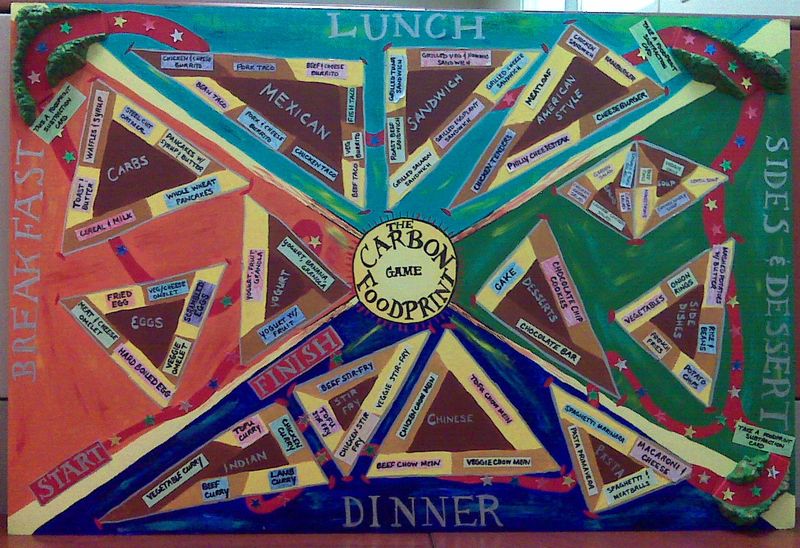The Carbon Foodprint Game: Bringing the Low Carbon Diet Calculator into the Classroom
- by tribe
As a part of a course I took last semester, I was asked to create a project addressing any geological concept for which I had an interest. Because the project did not have to explicitly relate to material being covered in class, I decided to create a board game using the information I had learned using Bon Appétit Management Company’s Low Carbon Diet Calculator. I wanted to theoretically offer the young adult audience a fun way to explore and learn more about the relationship between food, one’s carbon footprint, and global warming.
The term global warming seems to be discussed in almost every science class nowadays, but teachers make the same suggestions every time this issue comes up in conversation (I can almost hear my fourth grade teacher singing her off-key version of a popular reduce, reuse, recycle song, but thankfully I’ve been able to block out the majority of the high.jpgtched shrieking). Before playing around with the Low Carbon Diet Calculator, I must admit that I ate local and organic food primarily because of nutritional considerations. I had never considered the fact that, “the livestock sector emerges as one of the top two or three most significant contributors to the most serious environmental problems,” as a UN Food and Agricultural Organization’s article explains. And even more interesting, in my opinion, is that while environmental films have been praised for educating the public about the issue of global warming, most leave out the significant impact our food choices have on carbon dioxide and other greenhouse gas emissions.
So with all of this in mind, I created the Carbon Foodprint Game. The object is for each player to “eat their way” through a 24 hour day so that he or she can see which food choices are less carbon intensive and harmful to the environment. Each food has a point value determined by its CO2e (carbon dioxide equivalent emissions); these values were obtained from the Low Carbon Diet Calculator. So, in contrast to the object of most board games, the goal is to end up with the lowest total point value after completing all four rounds (Breakfast, Lunch, Sides/Dessert, and Dinner). During every round, each player must choose one meal. Then, after every player has chosen food for a round, everyone can find out how many CO2e points their food was worth. Each round has corresponding Food Point Cards that list the point values of each possible food choice. Another fun part of the game is what I deemed “Foodprint Subtraction Cards.” Each player takes one card after the completion of each “meal” (aka round) that quiz him or her on knowledge about the relationship between environmental degradation and food choices. If answered correctly, these cards have the ability to subtract points that have been accumulated by each player throughout the game.
Probably the most exciting part of the creation of this game was seeing people’s reactions during our class-wide science fair (there were close to a hundred people in our lecture). Since my name was nowhere on the project display, I found myself meandering by to see what people were saying as they played around. At first, as I expected, there was a lot of confusion. I mean, I used a few of the pieces from The Game of Life, but instead of money and cars lining the board, they found farm animal game pieces and Foodprint Subtraction Cards. Then came the inevitable question that I heard people ask time after time: “What do meals and food have to do with global warming?!” My head just about spun around every time I heard that, but these students stuck around, reading the direction booklet I had included and the paper I wrote to accompany the game. Then, a week or so later, I found out that the game tied for
– Nina Merrill, Student Intern
